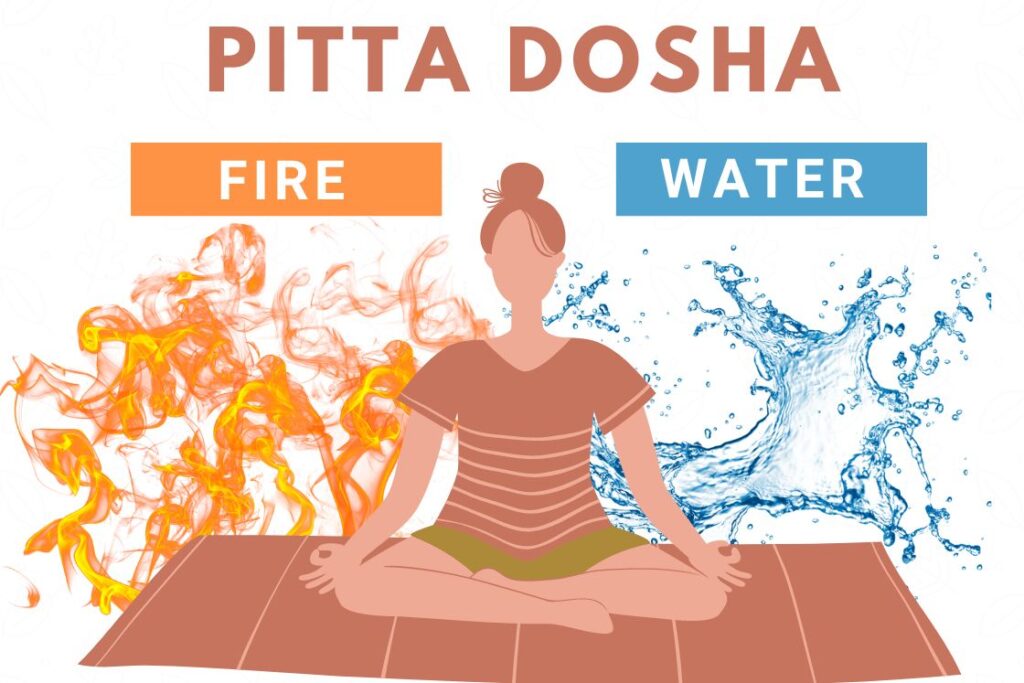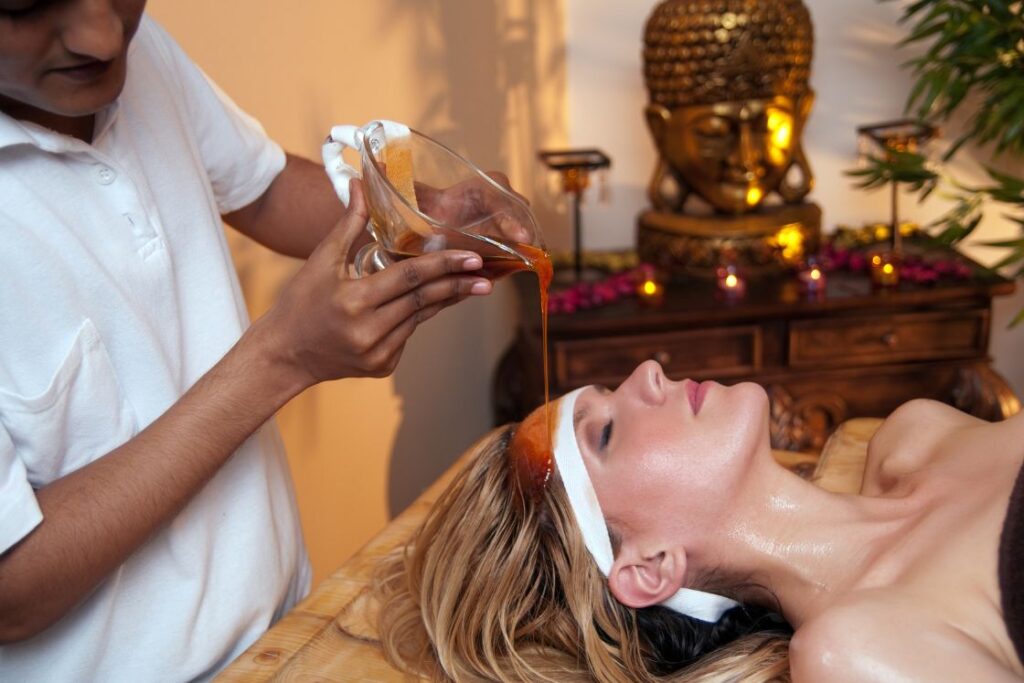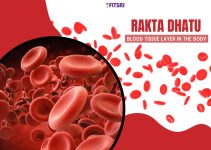- What is Pitta Dosha?
- Qualities
- Types of Pitta Dosha
- Pitta Dosha Symptoms
- Pitta Dosha Diseases
- Cause of imbalance
- Balancing Tips

Ayurveda, which is also known as the sister science of Yoga, has wonderfully outlined the 3 primary bio energies that govern our body. In English, we call them biological humour and Ayurveda calls it Tri Doshas.
Our body is made up of five elements, i.e., air, water, fire, earth, and space. And a combination of these makes up the 3 doshas – Vata (space+air), Pitta (water+fire), and Kapha (water+earth).
The Pitta Dosha is made up of fire and water where the fire is the dominant element. The fire element or pitta helps in providing energy to the body in the form of heat. In this article, we will look into the qualities and characteristics of Pitta Dosha, the symptoms of pitta dosha, and ways to keep it in balance.
What is pitta dosha?
The word Pitta doesn’t mean fire in the literal sense. It is commonly translated to “that which digests things”. Thus, the pitta dosha deals with mentally digesting life experiences and physically digesting food.
As stated earlier, the pitta dosha is made of fire and water ayurvedic elements. With fire being the dominant element, pitta dosha plays a vital role in the digestive system, as it is responsible for transforming and metabolizing food into energy and nutrients.
Pitta dosha is mainly located in the small intestine, liver, and gallbladder, where it happens in the form of water or oil or in simple terms, acids. These are crucial organs for digestion and metabolism.
Moreover, pitta dosha is also responsible for maintaining a healthy body temperature and regulating the body’s metabolism. Therefore, Pitta minorly is also located in the heart, blood vessels, and sweat glands, which are responsible for regulating blood flow and body temperature.
In the mental plane, pitta dosha is associated with intelligence, focus, and mental clarity. It is responsible for the sharpness of the mind and the ability to make decisions and communicate ideas effectively. Pitta is located in the brain, eyes, and tongue, which are essential for perception, analysis, and expression.
Qualities of pitta dosha

Each of the three doshas influences the physical, mental, and emotional characteristics of an individual based on their constituting elements (space, air, fire, water and earth). It’s called the quality of a dosha.
For example, pitta dosha qualities refer to the general attributes and nature of the mixed composition of fire and water elements.
Pitta dosha has the qualities of hot, sharp, light, oily, liquid, spreading, mobile, sour, pungent, and salty. These qualities describe the nature and behaviour of pitta in the body and mind, such as its ability to generate heat, digest food, communicate ideas, and experience emotions.
Let’s see each quality of pitta in brief:
- Hot: Pitta dosha is characterized by a hot quality, which means it tends to generate heat in the body and mind. This quality is used to improve digestion and metabolism, but excessive heat can cause inflammation and irritability.
- Sharp: Pitta dosha has a sharp quality, which means it can be intense, focused, and penetrating. This quality is used to enhance mental clarity and concentration, but excessive sharpness can cause criticism and judgment.
- Light: Pitta dosha has a light quality, which means it is easy to digest, absorb, and assimilate. This quality is used to improve energy and vitality, but excessive lightness can cause anxiety and restlessness.
- Oily: Pitta dosha has an oily quality, which means it can be smooth, lubricating, and moisturizing. This quality is used to nourish and hydrate the skin and other tissues, but excessive oiliness can cause congestion and lethargy.
- Liquid: Pitta dosha has a liquid quality, which means it can be flowing, nourishing, and hydrating. This quality is used to support the body’s fluids, circulation, and elimination, but excessive liquidness can cause fluid retention and congestion.
- Spreading: Pitta dosha has a spreading quality, which means it can be expansive, outward-moving, and communicative. This quality is used to promote creativity, communication, and connection, but excessive spreading can cause over-stimulation and distraction.
- Mobile: Pitta dosha has a mobile quality, which means it can be active, dynamic, and restless. This quality is used to support movement, metabolism, and change, but excessive mobility can cause instability and anxiety.
- Sour: Pitta dosha has a sour quality, which means it can be acidic, stimulating, and tangy. This quality is used to improve digestion, appetite, and absorption, but excessive sourness can cause heartburn and acidity.
- Pungent: Pitta dosha has a pungent quality, which means it can be spicy, penetrating, and stimulating. This quality is used to improve circulation, respiration, and immunity, but excessive pungency can cause inflammation and irritation.
- Salty: Pitta dosha has a salty quality, which means it can be mineral-rich, nourishing, and grounding. This quality is used to support electrolyte balance, hydration, and relaxation, but excessive saltiness can cause fluid retention and hypertension.
Types of pitta dosha
Based on its location in the body, there are 5 types of Pitta Dosha – Pachaka Pitta, Ranjaka Pitta, Sadhaka Pitta, Alochaka Pitta and Bhrajaka Pitta.
Pachaka Pitta is located in the stomach and intestine. This area is predominantly responsible for digestion. This pitta is also known as the strongest and primary subtype of pitta as it controls all the other subtypes of pitta.
Ranjaka Pitta has its seat in the liver and spleen. This area is responsible for the production of blood which is again a form of pitta.
Sadhaka Pitta is said to reside in the heart. The heart is responsible for maintaining emotional balance and assists in mental functions such as knowledge, intelligence, self-consciousness, stress, etc, which is associated with pitta dosha.
Alochaka Pitta is located in the eyes which controls the vision and perception of colour. Spiritually speaking, it governs the quality of seeing right from wrong.
Bhrajaka Pitta is present in the skin. The largest organ of the body is the first responder of the environment. It protects, helps with circulation, regulates temperature, and faces all external stimuli.
Symptoms of pitta dosha imbalance

When pitta dosha becomes imbalanced, it can cause a variety of health issues, both physical and mental. For example, excessive pitta can lead to inflammation, fever, acidity, skin rashes, and anger. In the mind, imbalanced pitta can cause irritability, judgmental behaviour, and criticism.
One of the most common signs of high pitta in the body is a yellowish tinge to the skin. This can occur due to excess bile production, which is a key characteristic of pitta imbalance. People with pitta imbalances may experience a persistent feeling of heat or warmth in their bodies, even when the environment is cool. This can also lead to excessive sweating and body odor, which can be difficult to manage.
You may experience the following symptoms of pitta dosha imbalance:
- Inflammation: Excess pitta can lead to inflammation in the body, causing redness, swelling, and pain in affected areas.
- Heartburn: When pitta in the stomach becomes too high, it can cause heartburn and acid reflux due to excess stomach acid.
- Skin rashes: Imbalanced pitta can cause skin rashes and irritation, as pitta governs the skin and its functions.
- Diarrhoea: When pitta is too high in the digestive system, it can cause loose stools and diarrhoea due to excessive heat and liquid in the body.
- Anger: Excessive pitta can lead to feelings of anger, irritability, and impatience, as pitta is associated with the fire element and can cause a buildup of heat in the body.
- Judgmental behaviour: When pitta is imbalanced in the mind, it can lead to critical and judgmental behaviour towards oneself and others, as well as an excessive need for control and perfectionism.
- Joint pain: When pitta is imbalanced and inflammation occurs, it can lead to joint pain and stiffness.
- Body odour: Excessive sweating due to pitta can lead to increased body odour.
- Thirst: Imbalanced pitta can cause excessive thirst, as pitta governs the water element in the body.
- Burning headaches: Pitta-related headaches can cause a burning sensation in the head and may be accompanied by sensitivity to light and sound.
- Hot flushes: Imbalanced pitta can cause hot flashes or sudden feelings of warmth in the body.
- Tenderness in breasts/testicles: Pitta can also accumulate in certain areas of the body, such as the breasts or testicles, causing tenderness or discomfort.
- Ego inflation: When pitta is imbalanced in the mind, it can lead to an inflated sense of ego and self-importance.
- Over attachment to goals: Imbalanced pitta can cause a hyper-focus on goals and accomplishments, leading to stress and burnout.
- Instability: When pitta is imbalanced, it can cause a sense of instability or uncertainty in the mind and body.
- Jealousy: Excessive pitta can also cause feelings of jealousy and competitiveness towards others.
When pitta is in balance, a typical pitta body type is medium built with well-built muscles. They have soft skin with an oily sheen to it. They can easily blush but also sweat profusely when exposed to heat, hence they should avoid the sun. Pitta people have straight hair which is prone to premature greying. They pose with loud and sharp voices along with almond-shaped eyes.
Read more: What does pitta body type look like?
Common health issues associated with pitta dosha

When there is an imbalance in the qualities and characteristics of pitta dosha, it can lead to health issues that are related to those specific qualities and characteristics. For example, if the hot and sharp qualities of pitta are imbalanced, it can lead to issues such as inflammation, heartburn, and ulcers.
When there is an excess accumulation of pitta in the body, you may experience the following health issues:
- Digestive issues: Pitta governs the digestive system, so when it is imbalanced, it can lead to issues such as heartburn, acid reflux, ulcers, diarrhoea, constipation, and poor digestion in general.
- Skin problems: Pitta governs the skin, and an excess of this dosha can lead to conditions such as acne, rashes, hives, and other inflammatory skin issues.
- Inflammation: Pitta is hot and inflammatory by nature, so an excess of pitta can lead to inflammation throughout the body. This can contribute to conditions such as arthritis, joint pain, and other inflammatory conditions.
- Hormonal imbalances: Pitta is also linked to the hormonal system, so an excess of pitta can lead to hormonal imbalances and related issues such as hot flashes, heavy menstrual bleeding, and other menstrual problems.
- Emotional issues: Pitta governs the emotions, and when it is imbalanced, it can lead to issues such as anger, irritability, impatience, and frustration. It can also contribute to a tendency to be critical or judgmental.
- Fatigue and burnout: When pitta is imbalanced, it can lead to a sense of burnout or exhaustion. This is because an excess of pitta can create a state of constant activity and stimulation, which can be draining over time.
- Eye problems: Pitta is also linked to the eyes, so an excess of pitta can lead to eye issues such as redness, dryness, and inflammation.
Causes of pitta dosha imbalance
We have already stated the symptoms of imbalanced pitta dosha however, what causes those imbalances?
Here are some causes:
- The improper diet that contains pitta-increasing ingredients or foods such as pungent, sour, salty, deep-fried, and processed food.
- Eating at the wrong hours or when angry
- Prolonged sun exposure
- Stress and tension due to emotional flare-ups
- Overworking and lack of sleep
- Consuming excessive tea, coffee, alcohol, nicotine
- Exposure to chemicals or toxins
- Loud and competitive environment
It is also said that with a change in season from late fall to winter, the pitta people should focus on taking a relatively lighter and cool diet than an average person would have in winter. The junction with Vata dosha makes it all the more important for detoxification and dietary regulation.
Balancing pitta dosha

The very cause of the imbalance or increase of pitta dosha is improper diet and excessive internal heat. Making dietary and lifestyle changes that involve food and light exercise can greatly help with balancing your pitta dosha.
1. Dietary Changes
Here are some dietary changes you can make to balance pitta dosha:
- Include sweet, bitter, and astringent tastes in your diet. These tastes help to cool down excess pitta.
- Avoid spicy, sour, and salty foods as they can aggravate pitta.
- Eat cooling foods like cucumber, watermelon, and mint to soothe excess pitta.
- Drink plenty of water throughout the day to flush out toxins and reduce heat in the body.
2. Lifestyle Modifications
Certain lifestyle modifications can help balance pitta dosha. Here are some tips:
- Stick to a regular routine and avoid erratic schedules.
- Get adequate sleep and avoid staying up late at night.
- Avoid direct exposure to the sun and heat.
- Never skip meals.
- Practice stress-reducing activities like meditation, deep breathing, and yoga to calm down pitta.
3. Yoga Exercises
Certain yoga exercises can help balance pitta dosha. Here are some of the best yoga poses:
- Sheetali Pranayama: This breathing exercise helps to cool down the body and reduce excess pitta.
- Seated Forward Bend: This pose helps to calm down the mind and release tension in the body.
- Dolphin Pose: This pose helps to reduce heat in the body and calm down pitta.
- Half Moon Pose: This pose helps to balance pitta dosha by stretching the spine and calming the mind.
4. Herbs
Certain herbs can also help balance pitta dosha. Here are some effective herbs:
- Brahmi: This herb helps to calm down pitta and soothe the mind.
- Neem: This herb has cooling properties and helps to reduce inflammation in the body.
- Amla: This herb is rich in antioxidants and helps to flush out toxins from the body.
- Turmeric: This herb has anti-inflammatory properties and helps to reduce excess heat in the body.
5. Ayurvedic treatments
Ayurvedic treatments such as Panchakarma, Shirodhara, and Abhyanga massage are known to balance pitta dosha by promoting relaxation, detoxification, and rejuvenation.
Conclusion
If you’ve figured out that you are a Pitta person, you would know that you will easily get angry and frustrated. You are prone to indigestion and may sweat a lot, causing a bad odour. Making some lifestyle changes slowly will help you get on track.
You can easily be in control of your life and body if you create a routine that is healthy for your physical and mental fitness.





Am a senior citizen aged 64yrs having Lower Stomach Burning problem for the last 15+ months, which is due to Pitta Dosha and prompted me to read article. I must appreciate it’s an excellent piece of detailed information provided here in.
It would be really great if you can help me more in addressing my problem naturally..
Am willing to consult over a video or regular call and pay the Consultation charges.
Request you to please advise.
God Bless